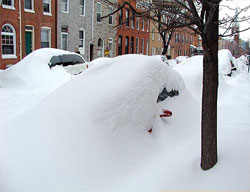 |
|
|
 |
||
|
||||||||||||||
|
Answer to How Winter Seasonal Forecasts Can Be Improved May Be Found in Siberia's Autumn Snows
Energy prices are at all-time highs, so winter weather, which significantly affects the U.S. economy, may have an even greater impact this season. National Science Foundation (NSF)-funded research by Judah Cohen of Atmospheric and Environmental Research (AER), Inc., in Lexington, Massachusetts, has led to the development of an experimental model, which may offer improved winter weather forecasts. Such forecasts can help guide planning for dealing with winter weather impacts. Most forecast models rely exclusively on global ocean temperatures for seasonal predictions, with a strong emphasis on tropical ocean temperatures in the Pacific associated with the El Niño. El Nino has been linked with surface temperature and precipitation patterns across the globe. However, the predictive power of El Nino is limited by its infrequent appearance, only once in every four or five years. In years when El Nino is absent, weak, or even moderately strong, its use as a predictor of upcoming winter weather has met with variable success. Using data from the land surface and the lower atmosphere, which are largely ignored by other forecast models, Cohen has found clues to upcoming winter conditions in the U.S. and Europe. Cohen pays particular attention to autumn snowfall amounts in Siberia, which, he maintains, have the potential to exert a major influence on winter climate. Satellite-observed snow cover departures from average are therefore incorporated into Cohen's prediction model. Cohen cautions that he has produced a limited number of real-time forecasts, and that it is premature to draw any definitive conclusions, but early successes show significant potential. Striking examples of these successes include the last two winters: For 2002-03, Cohen correctly predicted cold weather in the eastern U.S., while most government and private forecasters anticipated warm temperatures, their predictions based largely on El Niño conditions. Cohen's model also anticipated a cold winter for the northeastern U.S. for the 2003-04 season, while official forecast centers predicted an equal chance of warm, cold or normal conditions. Cohen will talk about the basis for his seasonal winter forecasts and how they differ from current methods.
Note to journalists: For information on Ecology of Infectious Diseases FY 2004 Awards see: http://www.nsf.gov/od/lpa/newsroom/pr.cfm?ni=15000000000122 The National Science Foundation (NSF) is an independent federal agency that supports fundamental research and education across all fields of science and engineering, with an annual budget of nearly $5.58 billion. NSF funds reach all 50 states through grants to nearly 2,000 universities and institutions. Each year, NSF receives about 40,000 competitive requests for funding, and makes about 11,000 new funding awards. The NSF also awards over $200 million in professional and service contracts yearly. Receive official NSF news electronically through the e-mail delivery and notification system, Custom News Service. To subscribe, enter the NSF Home Page at: http://www.nsf.gov/home/cns/#new and fill in information under “new users.” Useful NSF Web Sites:
|
||||||||||||||
|
|
|
|
